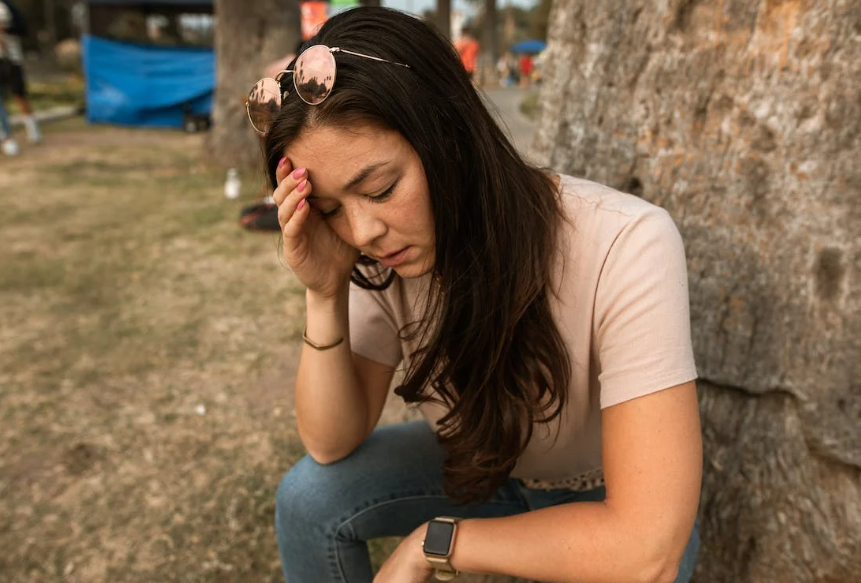Can Mindfulness Help with Anxiety?
Explore how mindfulness can help soften feelings of anxiousness, reduce stress, and calm a panic attack.

Selfpause Affirmation App
Download the app to get 1,000’s of affirmation meditations and everything you need to write, record and listen to your own.
If you suffer from anxiety, you might be wondering, “Can mindfulness help me with my anxiety?” Mindfulness can help you become more aware of your current state and learn to identify emotions and sensations. When you are aware of these, you can acknowledge them and let them go. It can also help you recognize unwholesome states of mind and disengage from them.
Meditation

Meditation is a great tool for combating anxiety. In addition to calming the mind, it helps people stay focused on the present moment. It also reduces the effects of anger. Less anger means less anxiety. Meditation techniques include deep breathing, relaxing the muscles, and peaceful imagery. Even short periods of meditation can help.
When you are meditating, you can focus on your breathing, the sounds around you, or another activity. Anxiety is most likely to show up at some point during the process, so try to resist it and return your attention to the present moment. Once you have noticed your thoughts, notice how they affect your body and what they are doing.
If you have a busy schedule, try to schedule time in your day to practice meditation. This way, it will become a habit. You may find that you have more clarity and are better at problem solving.
Mindfulness

One of the ways to practice mindfulness is to explore your feelings of anxiety. You can visualize the anxiety you are feeling and explore the details of it. Alternatively, you can explore how you feel as if you were not experiencing it at all. While imagining anxiety, you can relax your body and mind. Whether you are sitting on a chair or on the floor, try to remain calm and aware. Throughout the process, it’s important to notice the details and sensations surrounding you.
One study from the University of Waterloo shows that a simple 10 minute meditation session can dramatically reduce the amount of time you spend in ruminative thought patterns. The study involved 82 participants who were experiencing regular disruptions as they worked on a computer task. They were split into two groups, one of which listened to a guided meditation, and the other listened to an audio book. After the 10 minutes, the participants were sent back to the task.
Practicing mindfulness has been shown to reduce anxiety symptoms and even reduce some of the physical symptoms of the disorder. It helps people recognize when they are experiencing anxiety and helps them develop self-compassion. It also helps people view life more objectively, reducing the tendency to react to difficult situations.
Observation

Observation can help people learn new ways of responding to different situations. This can help people develop new strategies for coping with their anxiety. It also allows people to understand the details of the anxiety that they feel. This can be particularly helpful for those who experience social anxiety. The next time you feel a surge of anxiety, try observing the details of how you feel.
Once you’ve started observing yourself, you should take a moment to recall an event that has caused you anxiety in the past. Try to think about how you felt at that time, and consciously invoke that feeling in the present moment. You may even be able to feel the anxiety that has accumulated in your body.
You can also try observing the behavior of others. If they are not anxious, try to notice their movements and observe how they change. You’ll find that the behavior becomes less intense.
Focusing on breathing

Studies have shown that focusing on breathing has a powerful calming effect on the body. Focusing on breathing triggers changes in the brain that promote relaxation and reduce anxiety. It also triggers a parasympathetic response that reduces stress. It has a variety of other beneficial effects, including increasing confidence and mindfulness.
One study in the Journal of Personality and Social Psychology found that a slow breathing technique can reduce anxiety. People who used this technique before receiving an electric shock reported a decrease in their feelings of fear. In addition, they showed less anxiety in their physical states as measured by sweat production and blood flow to their fingers.
There are many breathing exercises that can help people reduce anxiety. One of these is yoga breathing, which emphasizes deliberate, mindful breathing. This method is useful for individuals who struggle with anxiety because it allows them to better control their body’s response to anxiety.
Reducing thoughts

One of the easiest ways to reduce anxiety is by reducing the number of thoughts you have at any given time. When we are anxious, our thoughts tend to focus on what will happen in the future. In order to combat this, psychologist Tamar Chansky, author of Freeing Yourself from Anxiety, suggests that you focus on the present instead. Instead of worrying about what might happen in the future, consider what needs to happen right now, and then revisit the situation later when you are calmer.
Another technique for reducing anxiety is to write down all the thoughts that cause you anxiety. Try writing down what you’re experiencing now, and what you worry about in the future. This can help you become more aware of your fears and help you change your circumstances. It also helps you explore different options, which can reduce your anxiety.
Keeping busy is another great way to reduce anxiety. Doing something you enjoy, like cleaning your house or doing the dishes, can help you take your mind off of your anxious thoughts. It also allows you to be more productive.
Effects of mindfulness on the amygdala

Meditation may help to improve the brain’s response to anxiety. The amygdala is an almond-shaped group of nuclei that is located in the temporal lobes. Studies show that excessive activity in this part of the brain can ensure a lifetime of worry. Mindfulness meditation may help to upgrade the amygdala. In addition to reducing stress signals, mindfulness meditation also reduces electrical activity in the fear center.
One study found that participants who practiced mindfulness meditation had reduced right amygdala activity when viewing pictures of positive and negative people. This finding fits well with the abundant literature on the amygdala. This region is unique in its role in processing negative emotions.
Mindfulness meditation also increased gray matter density in the hippocampus, a part of the brain responsible for memory. Researchers Britta Holzel and Sara Lazar also found that mindfulness meditation increased the activity in the prefrontal cortex, which is involved in top-down stress regulation. In addition, the brain activity in the amygdala was reduced, which suggests that the meditation technique is able to reduce the amygdala’s connectivity with other areas of the brain.
Effects of mindfulness on the body

Studies have shown that practicing mindfulness can help people deal with excessive worries. Mindfulness requires individuals to be aware of their thoughts, emotions, actions, and bodily sensations. It is crucial not to judge these feelings, but instead to name them and shift your attention to the present moment.
Mindfulness also can help those who are chronically ill deal with stress and disease. For example, a recent study showed that people who practiced mindfulness had lower levels of inflammatory markers, such as C-reactive protein. It also improved the immune system in patients with rheumatoid arthritis.
A study from Michigan State University found that mindfulness reduced anxiety in people who were suffering from psychosis. The study was conducted in a psychiatrist’s office, and twenty participants completed a questionnaire and performed a three-minute mindfulness exercise. Mindfulness was found to be more effective than traditional treatment and significantly reduced the number of patients who reported having suicidal thoughts.
Finding a mindfulness teacher

Finding a mindfulness teacher can help you learn how to deal with anxiety and stress. Practicing mindfulness is an easy way to stay grounded and avoid worrying about the future. One simple way to do this is to focus on the present moment by using your senses. This can be as simple as taking a deep breath or concentrating on something nearby. You can practice mindfulness in the comfort of your own home or even teach it to your students.
Practicing mindfulness can help teachers become more compassionate and patient with their students. It can help them recognize their own feelings of frustration or anger and express them in healthy ways. The benefits of mindfulness are numerous and it has been found to be an effective intervention for people dealing with mental health issues.
Our Top FAQ's
Mindfulness is a mental state achieved by focusing one’s awareness on the present moment, while accepting and acknowledging one’s thoughts and feelings without judgment. Research has shown that mindfulness can help with anxiety by reducing rumination (i.e., repetitive and negative thinking), increasing self-awareness, and improving emotional regulation. Practicing mindfulness can also help individuals to become more resilient to stress, which can in turn reduce anxiety.
There are many different mindfulness practices that can be helpful for managing anxiety. Some common ones include:
-
Sitting meditation: This involves focusing on one’s breath, a mantra, or an object, and returning to this focus whenever the mind wanders.
-
Body scan: This involves lying down and focusing on different parts of the body, noticing any sensations or tension without trying to change them.
-
Loving-kindness meditation: This involves silently repeating phrases of goodwill and sending positive energy to oneself and others.
-
Walking meditation: This involves paying attention to each step and the sensation of the feet touching the ground.
Mindfulness can be a useful standalone treatment for anxiety, but it is often most effective when used in combination with other therapies or medications. Some common treatments for anxiety that may be used in combination with mindfulness include cognitive-behavioral therapy (CBT), medication, and relaxation techniques such as deep breathing or progressive muscle relaxation.
To get started with mindfulness practice for anxiety, it can be helpful to:
- Find a quiet, comfortable place to sit or lie down
- Set a timer for 5-10 minutes to begin with
- Focus on the breath or another object of attention (e.g., a mantra or a candle flame)
- When the mind wanders, gently redirect the focus back to the breath or object of attention
It can also be helpful to find a mindfulness app or online course, or to attend a mindfulness class or workshop.
For most people, mindfulness is a safe and effective way to reduce anxiety. However, as with any mental health treatment, it is important to speak with a healthcare professional if you have concerns about your anxiety or if you are considering using mindfulness as a treatment. In rare cases, mindfulness practices may cause an increase in anxiety or other negative emotions, or may trigger past trauma. In these cases, it is important to seek support from a qualified healthcare professional.
